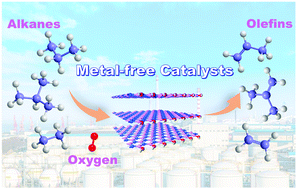Oxidative dehydrogenation of light alkanes to olefins on metal-free catalysts
Abstract
Metal-free boron- and carbon-based catalysts have shown both great fundamental and practical value in oxidative dehydrogenation (ODH) of light alkanes. In particular, boron-based catalysts show a superior selectivity toward olefins, excellent stability and atom-economy to valuable carbon-based products by minimizing CO2 emission, which are highly promising in future industrialization. The carbonaceous catalysts also exhibited impressive behavior in the ODH of light alkanes helped along by surface oxygen-containing functional groups. This review surveyed and compared the preparation methods of the boron- and carbon-based catalysts and their characterization, their performance in the ODH of light alkanes, and the mechanistic issues of the ODH including the identification of the possible active sites and the exploration of the underlying mechanisms. We discussed different boron-based materials and established versatile methodologies for the investigation of active sites and reaction mechanisms. We also elaborated on the similarities and differences in catalytic and kinetic behaviors, and reaction mechanisms between boron- and carbon-based metal-free materials. A perspective of the potential issues of metal-free ODH catalytic systems in terms of their rational design and their synergy with reactor engineering was sketched.

- This article is part of the themed collection: Recent Advances in Alkane Conversion


 Please wait while we load your content...
Please wait while we load your content...